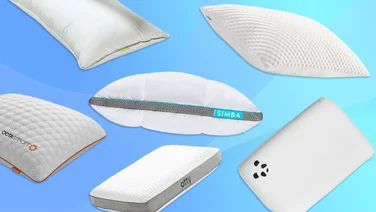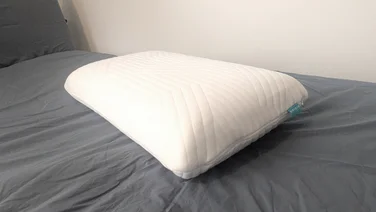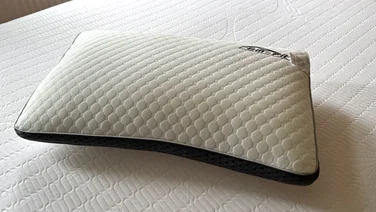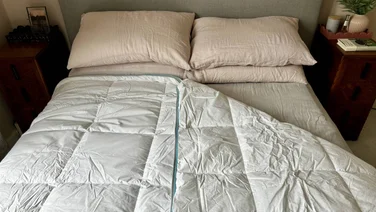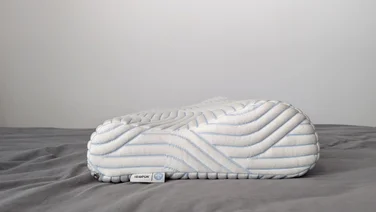To help us provide you with free impartial advice, we may earn a commission if you buy through links on our site. Learn more

Buying pillows can often be something of an afterthought, with many of us lured by sale offers and supermarket bargains, but have you actually considered which might be right for you?
Your pillow choice can actually make a huge difference to your quality of sleep and the type that suits you best will largely depend on your preferences and sleep position.
Read on as we reveal the benefits and the downsides of these pillow types to help you decide which is most compatible with your sleep style.
Feather vs memory foam vs microfibre pillows: Which is best for you?
We spoke to a clutch of industry experts to help us get a clear picture of the pros and cons of each pillow filling. Here’s what we discovered.
Feather pillows

The pros
Not all feather pillows are the same. According to James Montgomery-Castle, buyer at Soak & Sleep, duck feather pillows are ideal for back and side sleepers as they provide a firmer and supportive sleeping surface, while goose feather and down pillows tend to be very soft and lofty, making them perfect for front sleepers. As feather pillows mould to the contours of your head and neck as you sleep, they’re one of the most versatile pillow types, naturally adjusting to suit your sleeping position.
Not only that, they’re inherently breathable, allowing air to circulate as you sleep, keeping you cool throughout the night. “Feather pillows are also eco friendly, as ethically sourced feather and down is a by-product of the food industry”, explains Jonathan Attwood, co-founder at Scooms. “What’s more, the fillings are biodegradable, having less of an environmental impact than their synthetic counterparts.”
The cons
However, Attwood warns that it’s important to invest in premium feather pillows, as low-quality feathers can feel spiky if the casing isn’t robust enough. Feathers improperly washed during the manufacturing process can also emit an unpleasant smell, plus some feather pillows may require professional cleaning, making them potentially more high maintenance, so it’s worth checking the label first before you buy. Lastly, feather pillows can pose a challenge for allergy sufferers, as they often aren’t hypoallergenic.
Memory foam pillows

The pros
Made from viscoelastic foam, memory foam pillows are designed to contour to the shape of your head and neck for tailored support. According to Attwood, they’re ideal for those who prioritise spine alignment and pressure relief, and for those who suffer from neck and back issues. A good-quality memory foam pillow is highly durable and will retain its shape over time, plus they’re great at isolating movement (ideal if you or your partner have a tendency to fidget), ensuring undisturbed sleep.
Side sleepers get the most benefit from memory foam pillows – and with more than 60% of us preferring this position according to The Sleep Foundation, that makes the memory foam pillow a good contender for the majority. “They are designed to distribute weight evenly and reduce pressure points while maintaining optimal neck alignment,” says Danielle Mason, head of product development The Fine Bedding Company. They’re also hypoallergenic, making them suitable for allergy sufferers, as they resist pesky dust mites.
The cons
Founder of Naturalmat Mark Tremlett points out that the potential issue with memory foam pillows, however, is that they tend to retain heat, which can be uncomfortable for hot sleepers, although designs with modern cooling technology can help mitigate this. Attwood also notes that they aren’t the most environmentally friendly choice as they aren’t biodegradable and can emit a mild off-gassing smell when first used. It also comes down to personal preference – if you prefer a super-soft pillow to sink into, you may find that a memory foam pillow a little too firm for your liking.
Microfibre pillows

The pros
“Microfibre is a fine, synthetic fibre, which is soft and silky,” explains Attwood. “Pillows made from this can provide good neck support, if well packed.” With a plump and bouncy feel that often mimics down, microfibre pillows are great for back sleepers according to Mason, as they can adapt to your sleeping position and resist flattening, helping to reduce discomfort and stiffness. “These synthetic pillows also often incorporate innovative materials for specialised properties such as anti-allergy, cooling and temperature regulation,” adds Mason.
Not only that, they’re easy to maintain, often machine washable and quick drying, ensuring better hygiene and ideal for busy households. Plus, they’re a solid affordable option for those on a budget.
The cons
“Although microfibre pillows might seem more appealing to those looking to save money, it’s important to note they offer the least amount of support and longevity,” says Tremlett. “The synthetic filling can feel soft at first but can lose its shape and become lumpy after long periods of use.” Attwood also notes that they aren’t as breathable as the natural options, and again, while often made of recycled plastics, they aren’t biodegradable and can leak microplastics into the environment when washed.
Conclusion (TL;DR)
“When it comes to choosing the right pillow for you, there are four important elements to consider: the filling and materials used, level of support for your sleep position, size and any standards that you consider important,” says Attwood. “It’s ultimately about choosing what you feel is best for you.”
Buy a feather pillow if… you want a natural product that feels soft, luxurious and breathable. If you need support, go for duck feathers; if you’re a front sleeper, or you like a soft pillow to sink into, go for goose feathers or down.
Buy a memory foam pillow if… you want a durable, long-lasting pillow that provides superior support, especially if you’re prone to back or neck issues, or you wriggle a lot at night.
Buy a microfibre pillow if… you’re on a tighter budget. These pillows are hypoallergenic, practical and versatile – just don’t expect them to last as long as the other options.
Check out our pick of the best pillows on the market today for tried and tested recommendations.

